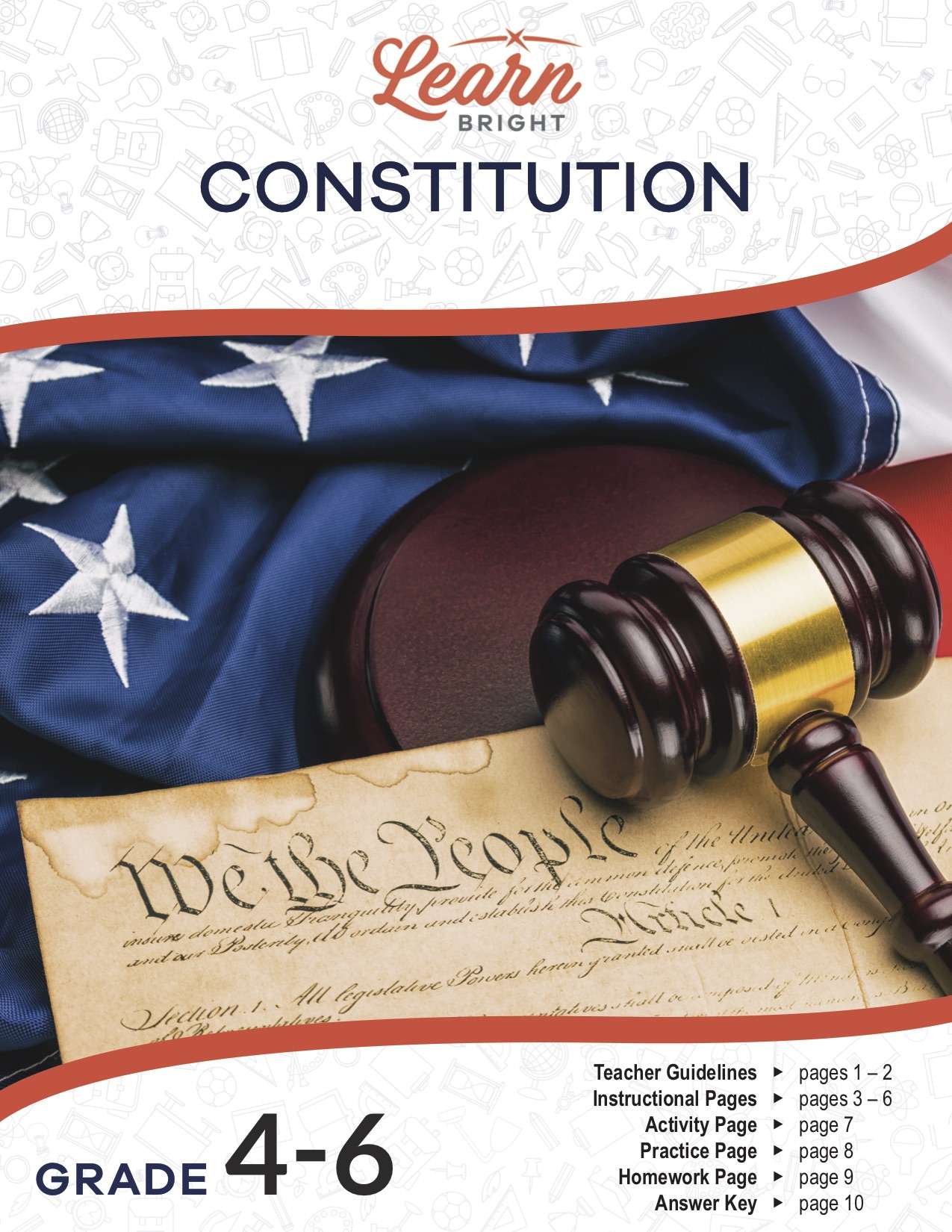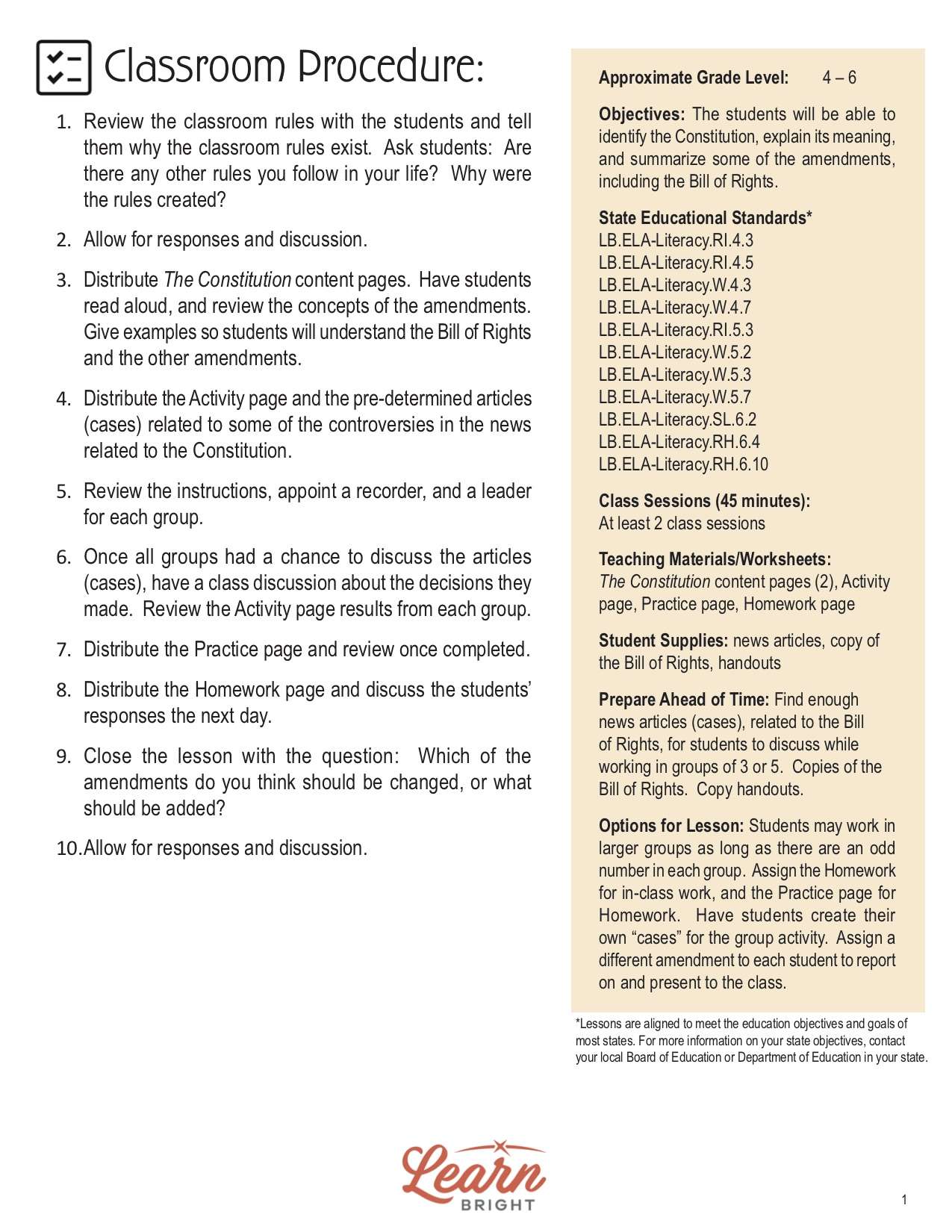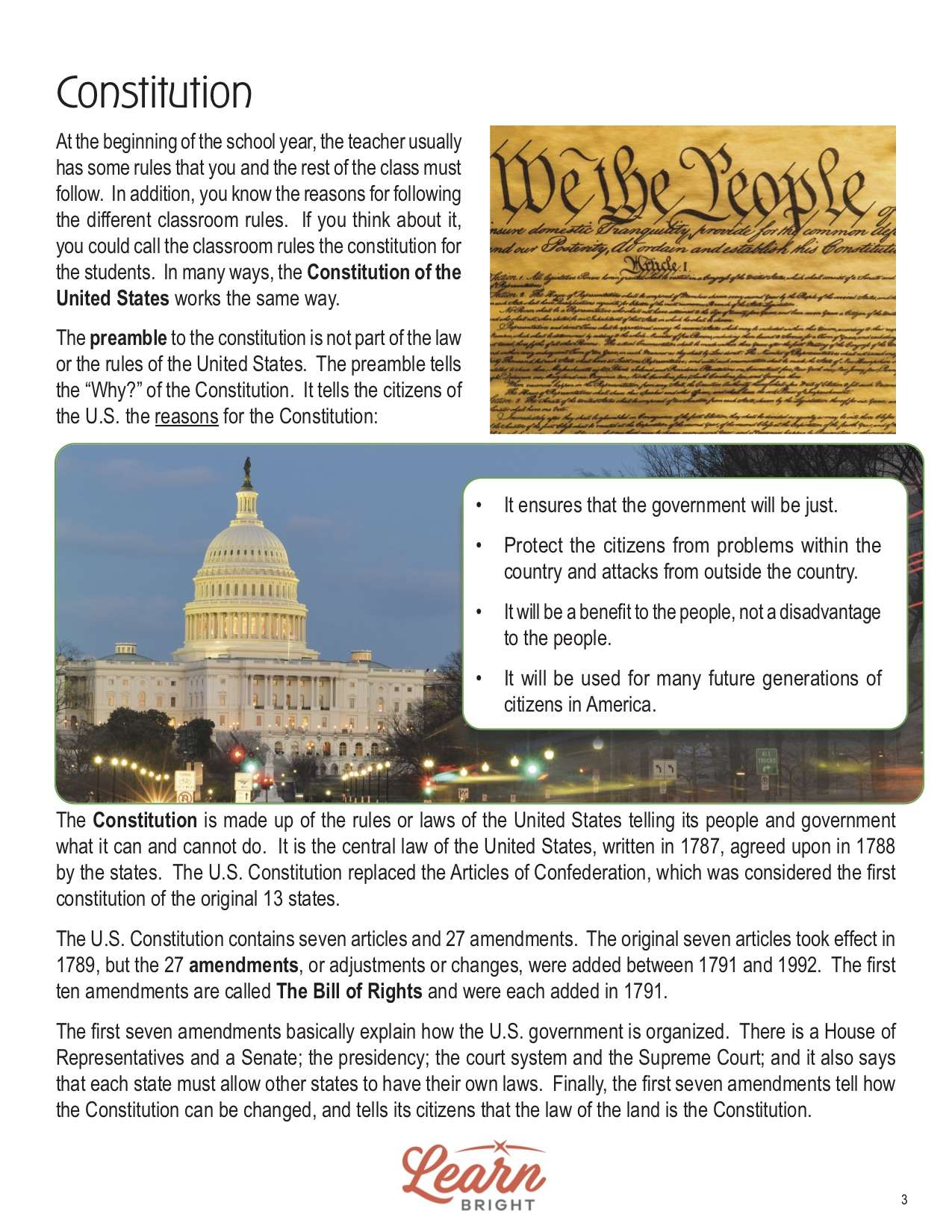Description
What our Constitution lesson plan includes
Lesson Objectives and Overview: Constitution teaches students about this important historical document. Students will discover how the ideals in the document shaped the United States government. They will learn about the Bill of Rights and several amendments. This lesson is for students in 4th grade, 5th grade, and 6th grade.
Classroom Procedure
Every lesson plan provides you with a classroom procedure page that outlines a step-by-step guide to follow. You do not have to follow the guide exactly. The guide helps you organize the lesson and details when to hand out worksheets. It also lists information in the yellow box that you might find useful. You will find the lesson objectives, state standards, and number of class sessions the lesson should take to complete in this area. In addition, it describes the supplies you will need as well as what and how you need to prepare beforehand.
Options for Lesson
You can check out the “Options for Lesson” section of the classroom procedure page for additional suggestions for ideas and activities to incorporate into the lesson. Students may work in larger groups as long as there is an odd number in each group. Assign the Homework for in-class work and the Practice page for homework. Have students create their own “cases” for the group activity. Assign a different amendment to each student to report on and present to the class.
Teacher Notes
The paragraph on this page gives you a little more information on the lesson overall and describes what you may want to focus your teaching on. It suggests you expand the lesson according to the level of your students. The blank lines are available for you to write out any thoughts or ideas you have as you prepare.
CONSTITUTION LESSON PLAN CONTENT PAGES
Introduction
The Constitution lesson plan contains four pages of content. At the beginning of the school year, the teacher usually has some rules that you and the rest of the class must follow. In addition, you know the reasons for following the different classroom rules. If you think about it, you could call the classroom rules the constitution for the students. In many ways, the Constitution of the United States works the same way.
The preamble to the constitution is not part of the law or the rules of the United States. The preamble tells the “why” of the Constitution’s existence. In other words, it describes the reasons we have a Constitution for the country. It ensures that the government will be just. It aims to protect the citizens from problems within the country and attacks from outside the country. The Constitution will be a benefit to the people, not a disadvantage. And finally, it will be used for many future generations of citizens in America.
The Constitution of the United States
The Constitution is comprises the rules or laws of the United States, telling its people and government what it can and cannot do. It is the central law of America, written in 1787 and agreed upon in 1788 by the states. The U.S. Constitution replaced the Articles of Confederation, which we once considered the first constitution of the original 13 states.
The U.S. Constitution contains seven articles and 27 amendments. The original seven articles took effect in 1789. Over time, the government has added the 27 amendments, or adjustments or changes, between 1791 and 1992. The first 10 amendments are called the Bill of Rights, and we added each of them in 1791.
The first seven amendments basically explain how the U.S. government is organized. There is a House of Representatives and a Senate, the presidency, and the court system and the Supreme Court. It also says that each state must allow other states to have their own laws. Finally, the first seven amendments tell how the Constitution can be changed. It also tells its citizens that the law of the land is the Constitution.
The Bill of Rights
The government added the Bill of Rights after some people thought the government had too much power. Here are a few of the rights for citizens:
- People have the right to practice their religion, make speeches, write and distribute news, and meet with others in public or private. And they have the right to ask the government for something.
- There is a controversial right that basically gives people the right to own a gun, though many people believe guns were only permitted by soldiers who needed them for war. People in America have many disagreements over the Second Amendment.
- Police cannot search people or their homes without a reason, and they must have permission from the court. Also, if someone is accused of committing a crime, they must have a lawyer at trial and do not have to speak when questioned. If they are found not guilty of a crime, they cannot go to court again for the same crime. Rights are also included for those in prison; people do not have the right to treat prisoners cruelly.
- Just because something may not be listed in the Constitution, that does not mean a person does not have a right. For example, there are no amendments prohibiting driving or allowing driving, but people do have a right to drive if they are permitted by law.
Some of the remaining 17 amendments are related to the following:
- The method of electing a president, including limiting a president to two terms
- Abolishing slavery and giving all citizens over 18 the right to vote, including women, without charging them a tax, which is what used to happen in some parts of the country
- Gives permission to the federal government to collect an income tax
- Initially, selling and using alcohol was not permitted, but another amendment changed that law.
In Summary
If a citizen or the government wants to make a change to the Constitution, it involves a long process. This is because it is very difficult to change. There are several steps involved. For one thing, 38 out of the 50 states have to agree with the change and want to make the change.
The Constitution is one of the most important documents of the United States. There are many other countries in the world that do not give their citizens the same rights a person receives in America. Sometimes the Constitution is described as a “living document” because it was not only written for the people in 1787 but also for future generations.
CONSTITUTION LESSON PLAN WORKSHEETS
The Constitution lesson plan includes three worksheets: an activity worksheet, a practice worksheet, and a homework assignment. Each one will help students solidify their grasp of the material they learned throughout the lesson. You can refer to the classroom procedure guidelines to know when to hand out each worksheet.
SUPREME COURT CASES ACTIVITY
You will divide students into groups of three or five people. You are welcome to make the groups bigger, but there must be an odd number of students in each group. Each students will be a temporary Supreme Court member. One person will read the article (case) out loud while the rest listen. The leader, who you will designate beforehand, will clarify the decision that the court needs to make for the case. The groups will discuss options and then vote. Each person can try to convince others to vote with them if others disagree. After a set time, students will submit their final votes. They will repeat this process for three more cases.
AMENDMENTS PRACTICE WORKSHEET
For the practice worksheet, students will review the summary versions of seven of the first 10 amendments. They will then have to match them to the scenarios they correspond to. There are 10 scenarios total, so students will have to use some of the amendments more than once.
WRITE YOUR OWN CONSTITUTION HOMEWORK ASSIGNMENT
The homework assignment requires students to write their own Constitution. The worksheet provides a scenario in which students are stranded on a desert island with 24 other people. Students must write a Constitution for the 25 people on the island as part of a mini government. They will need to include at least 10 amendments that are clear, neat, and specific.
Worksheet Answer Keys
There is an answer key for the practice worksheet at the end of the document. The correct answers are in red to make it easy to compare them with students’ responses. If you choose to administer the lesson pages to your students via PDF, you will need to save a new file that omits these pages. Otherwise, you can simply print out the applicable pages and keep these as reference for yourself when grading assignments.









